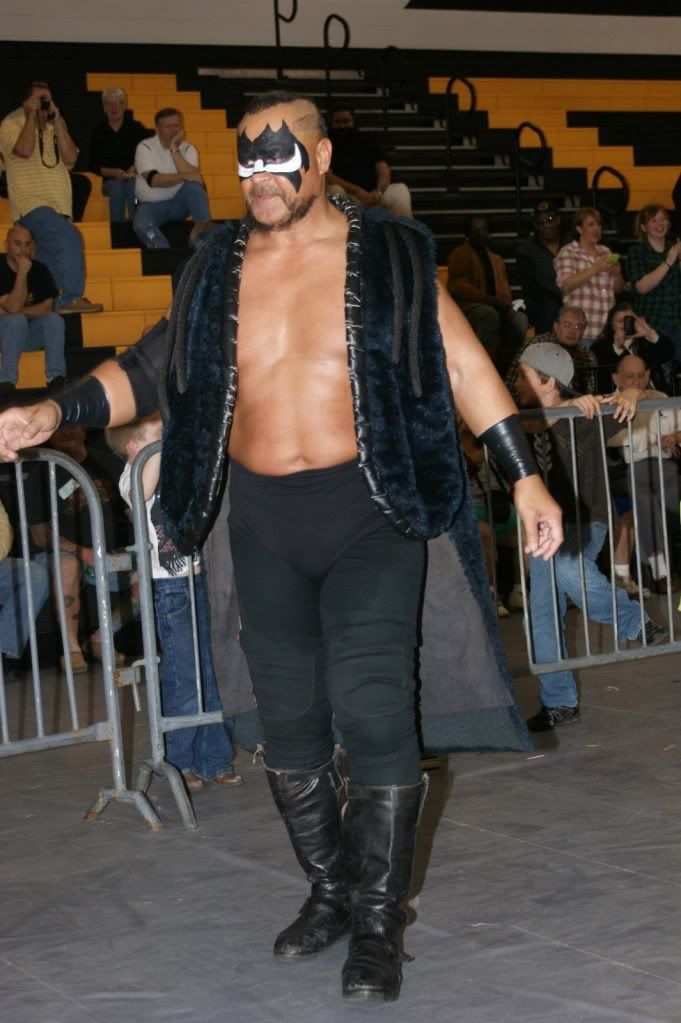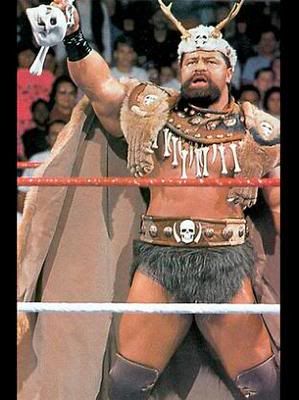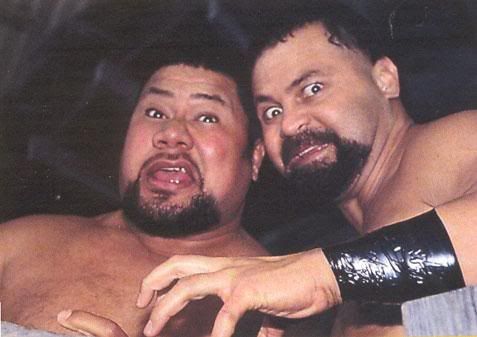wrestling / Columns
Going Broadway 06.05.12: And His Name Was Barbarian…

As a kid growing up, there were three sacred wrestling tapes that would make the rounds of my VCR as part of my own person home theatre exhibition. One was Wrestlemania VII, with Hogam versus Slaughter for Wrestling’s interpretation of Gulf War supremacy. Two was Summerslam ’91, with Bret Hart’s first WWF title as a singles wrestler, Macho Man’s wedding, and the night the Mountie spent the night in jail.
The third was a tape entitled WWF Superstars, a mix tape of random matches with the top draws in the company. Of course there was Hogan, Savage, and Warrior. The obvious inclusions. But it was the opening match I remember and recall so well: a handicapped match between Demolition and the Powers of Pain.
The theatricality of the match was immediately striking. Clad in black leather with demon-like face paint, Demolition was a clear callback to George Miller’s cult classic film The Road Warrior. Powers of Pain, were a post apocalyptic reciprocal to Demolition. Their names, Warlord and Barbarian reflected their appearance: back alley bruisers sent through time to fend off the armies of Genghis Khan, while covered in their own frightening face paint. Their manager, the maniacal, Mr. Fuji, was suited for battle himself, creating the handicap for Demolition.
The match was an absolute bruiser. A callback to to classic brute force in the ring, while simultaneously dismissing the art of classic Greek style takedowns for clubbing shots to the abdomen and lower back. A destructive festival of power and strength. Such could have been assumed from their ominous monickers. The finish of the match was fitting. The sniveling swine Fuji attempted to throw the white powder in the eyes of Demolition, but instead blinded the eyes of his tag team partner and ended up taking the signature elbow drop from Axe and Smash. The fan favorites went over at Trump Plaza.
As the years went on, Warlord and Barbarian would take singles routes as wrestlers, still maintaining their fear provoking personalities. Barbarian, in particular, I remember as part of Bobby Heenan’s “family” of wrestlers during the early 90’s as a mid card heel to oppose the likes of Hogan and Big Boss Man. He would also frequently find himself as the tag team partner of Haku. Later, in WCW, he would continue to appear with Haku (then under the name Meng)as part of the Faces of Fear. Same schtick for Barbarian. Just a relocation down south.
But as the Monday Night Wars era faded to black with WWE’s acquisition of WCW, so did Barbarian’s tenure on the main stage after well over twenty years in the wrestling business…
Nearly a decade later, I have a bit of a lump in my throat. Trepidation grips like a Ted Nugent “Stranglehold”. The same aforementioned Barbarian sits ten feet away. His face painted in the same Powers of Pain style I saw as a kid on that Superstars tape.
Despite being nearly twenty years older than I was back then and a little bit taller, I still look at Barbarian like he could headbutt if I said something wrong, and I wouldn’t wake up for five years.
What do I call this man? I hear him referred to as Barb by the other wrestlers. Do people just walk up to him and call him Barbarian as if man and character never separate? It’s like when I was six and used to wonder if Ultimate Warrior signed his checks under the same name. As if the electric company would have service for a man under such a handle and mail invoices to Parts Unknown.
Barbarian’s real name escapes me. I’ve looked it up recently in preparation, but the Tongan pronunciation is too foreign to recall a syllable. I would probably sound like a fool. I also worry about the reliability of my tape recorder, which seems Soviet and inefficient in button design. I’m such a second-rate reporter.
But funny enough, there’s a calming reassurance I get from Barbarian’s chuckling grin as he puts a pinch of tobacco in his lower lip. He sits down and calls over Mike Griffie, his business manager of sorts on the independent circuit. He resembles Kurt Cobain with shorter hair and acts as the mouthpiece in answering my questions.
What fascinates me the most about the man sitting before me is the fact that as a wrestler, Barbarian has navigated the major eras of the wrestling business and managed to sustain a certain amount of relevancy. As I ask how he was able to achieve that sustainability, he nods and communicates briefly in short, brief answers. Griffie fills in the blanks.
“Barbarian has been able to wrestle constantly throughout the years, and as much as the eras changed around him, he was also able to adapt his style to what the crowds wanted… In the 80’s, which is considered ‘old school’ now, the wrestling was a lot slower and more powerful. In the 90’s, of course, it was about the Attitude Era, which through his size and stature, Barbarian was able to stay relevant despite the need for bigger, riskier spots. Nowadays, it’s about his overall experience that he brings to ring, which allows him to wrestle anybody no matter their experience level.”
Barbarian methodically rocks back and forth on the bench he sits on, staring into a particular spot in the floor. I can tell he’s in that zone like when Heenan would build him up during one of those backstage promos that would appear on WWE television.
Other wrestlers from the independent show that has just ended stop to talk to him or get a signed poster, but Barbarian politely declines until the interview is over.
I am honored by his commitment to our time, as if I was on some kind of level plane with Bill Apter or Mike Mooneyham. I can’t help but ask him how a man from Tonga, sent over by his own king to Japan to study the art of Sumo, transitioned to professional wrestling in the United States. Griffie draws the parallels between the two and how the training benefited Barbarian.
“After coming over to the States, it was the Sumo wrestling that made the transition so smooth for the guys who came from Tonga. Barbarian was able to maneuver his size around the ring and maintain balance while being able to push opponents around. The balance is and has been the key to his strength over the years.”
Strength was the key factor in charting Barbarian’s success with Warlord as Powers of Pain, which is widely considered where his push began in the business. A timely and famous feud with the Road Warriors set the NWA landscape ablaze, culminating in many highly regarded tag matches and even in the infamous weight lifting contest at the Great American Bash where the Pain crushed Animal’s eye socket.
Upon entering the WWE, the Pain were originally fan favorites built primarily around their bruising history in the NWA. The heel turn came against Demolition when Fuji jumped shipped ship as manager, turning Demolition into fan favorites themselves.
When Powers of Pain went their separate ways, Barbarian overhauled his image, discarding his previous incarnation for the brown fur attire and antler headpiece he would wear for entrances. His singles career saw him score a victory over Tito Santana at Wrestlemania VI, but very soon he would be thrust back into the tag team scene with Haku, whom he would team with until the final days of WCW.
“With Warlord, it was about power. With Haku, it was about aggression,” Barbarian bluntly, simply relates as he rises his head.
But what I am curious about is how Barbarian, a man of continued fame and stature, has avoided the national stage for ten years despite the constant love for nostalgia in today’s wrestling business. I inquire about any desire he would have to return to WWE, where he had his most fame and success.
Barbarian’s head shakes no as if he’s completed this line of thought long ago.
“My time is over,” he says, again very directly minus any ornate romantic explanation. “Barbarian is a big proponent of new talent getting their push. He’s had conversations with WWE, and we’ve entertained ideas, but Barbarian enjoys the independent circuit and the personal connection with the fans,” Griffie adds.
Griffie even mentions a deal that was in the works to bring back Powers of Pain with the reformation of ECW within WWE, but it was a deal that fell through because WWE showed more interest in bringing in Barbarian than Warlord, something Barbarian would not agree to.
Barbarian’s presence in the main event of the OSCW show indicates how he has transitioned to the role of traveling mentor. Tagging with local grappler Glen Lane, the two opposed former WCW star Lodi and regional wunderkind John Skyler (the West Skylerwood Blondes). With the show billed as a benefit for local coach Phillip Morgan, who was stricken with a paralyzing stroke last year, Barbarian is uncharacteristically billed as the face in the match.
He is an immediate draw for the children in attendance, but never draws attention to himself during the match. Instead he gracefully puts the younger Skyler over in spots and supports partner Lane, who has not been in the ring for fifteen years. He even goes as far as to go into the crowd and greet Coach Morgan with a handshake and a hug.
A long way, coming from the guy who crushed Animal’s eye over twenty years ago.
My final question is basically my Barbara Walters “If you were a tree, which tree would you be?” or James Lipton’s “What is your favorite curse word?” kind of closer. I look back on it now and find zero originally in it and a terrible sense of pretense. But no one seems to let on at the time.
“What are you asked the most on the road?”
Barbarian sinks into his bench again, thinking. His mind works backwards through hundreds of thousands of wrestlers, matches, and shows.
I start to hear a chuckle, and he raises his head.
“Is Warlord still alive?”
Griffie and I laugh in return. From working Trump Plaza and the Toronto Skydome all the way to Goose Creek High School in Charleston, South Carolina, he still maintains an amiable sense of humor. No ego. No sense of entitlement. Just a forehead branded with scars and a heart of selfless return to the business that made him a household name.
It’s strange to see Barbarian exit with Griffie, wearing a t-shirt and jeans along with a ball cap while his fur entrance coat is stuffed in his bag. He is on his way back to North Carolina tonight. Most likely to resume his job as a construction manager in Charlotte on Monday morning. Imagine that. Your house might be the design of one half of Powers of Pain. If nothing else, you can guarantee it’s probably tough as hell, much like the man himself.
When I get back into my car, I go on the Internet and read the name Sione Vailahi from my search page. Yeah, I would have sounded like an idiot trying to say that.
But for the record I am able to verify one pressing fact: Warlord is indeed very much alive.
And as such the legacy of Powers of Pain lies preserved like the leopard in Hemingway’s Snows of Kilimanjaro , frozen at the summit, forever remembered in its prime in the hearts and minds of classic wrestling fans.







